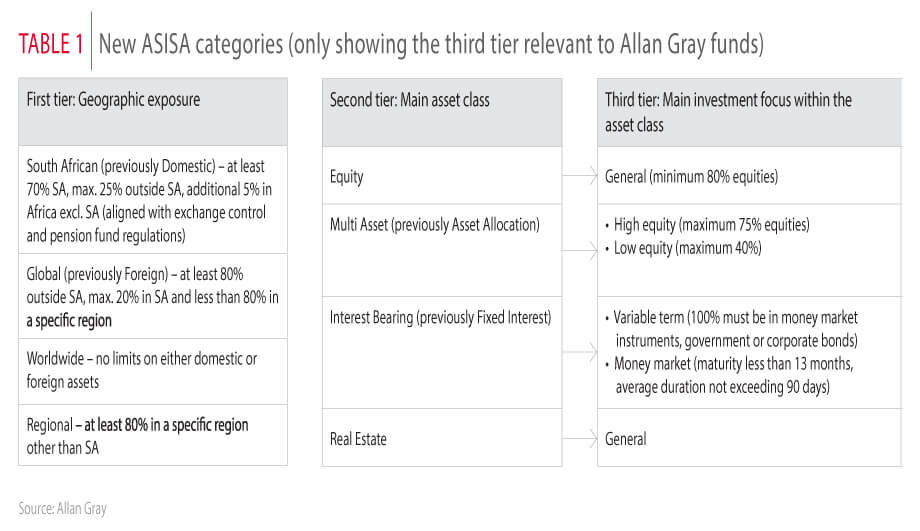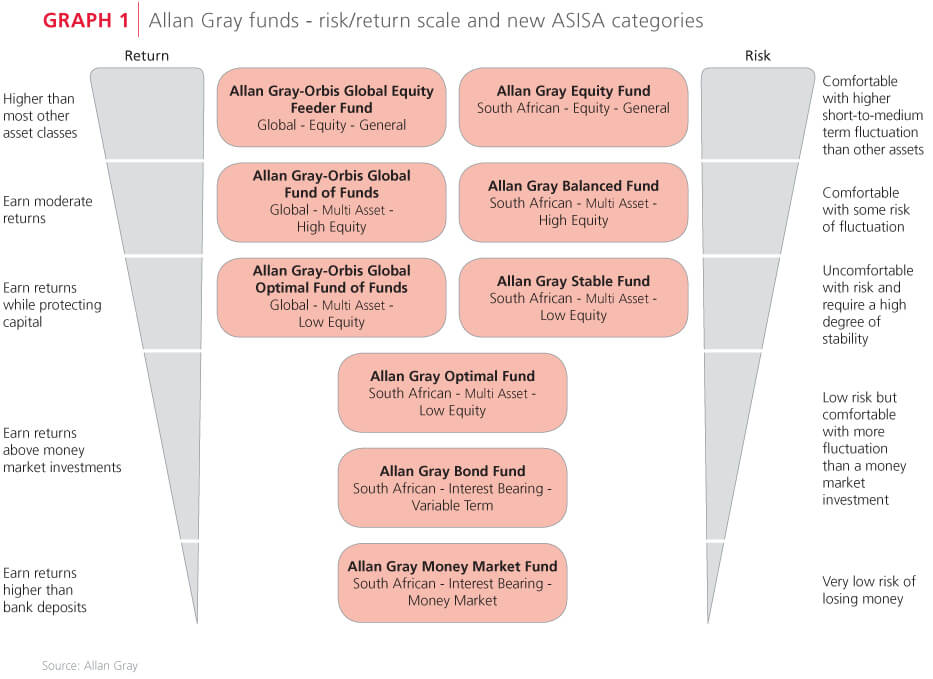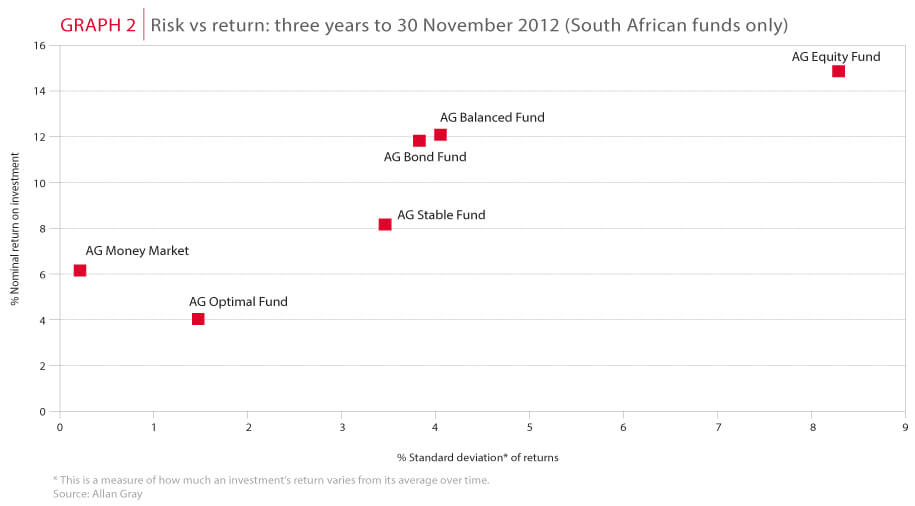We aim to ensure that our range of funds offers enough choice to meet your needs but remains manageable, without being confusing or creating too much overlap. This is why we offer only nine funds. We hope this makes it easier for you to research your options and make appropriate decisions. We encourage you to be clear on your investment objectives at the outset and to try to minimise switching in and out of funds, which often destroys value. If you do your homework, you are more likely to make the right decisions and remain committed over the long term. Rob Formby offers some pointers.
Things to consider when choosing a fund
When choosing a unit trust, it is important that you understand the funds that you are planning to invest in. Consider how a fund is categorised and what the fund manager's intention is with each of its funds. This information, which is readily available on the fund's factsheet (a compulsory document fund managers need to make available each month, usually found on the fund manager's website), should steer you in the right direction.
1.Fund categories
To help investors make sense of the huge amount of choice in the unit trust industry, the Association for Savings and Investments SA (ASISA) puts funds into categories. These have recently been revised for added clarity. All funds are now classified first according to their geographic exposure, then, within each of these, the types of assets they invest in. Within each asset class there is a third tier which indicates the main investment focus (see Table 1 for a breakdown of the categories, simplified to show only those third tier categories that are relevant to the Allan Gray funds, and Graph 1 for the actual Allan Gray fund classifications).

2. The intention of the funds
While the category of the fund gives good insight into what the fund invests in, it is also important to understand what the fund manager wishes to achieve. Allan Gray's broad intentions are discussed below. More specific details are included in the fund objectives, which are also documented in the fund factsheets.
All nine Allan Gray funds are priced in rands; however six are invested in local assets and three in offshore assets. The three funds invested in offshore assets all use Orbis funds as their underlying investments. Orbis and Allan Gray are closely aligned, sharing the same philosophy, founder and majority shareholder. It therefore makes sense that the Orbis funds form the basis of the investment.
Of our nine funds, five are 'single asset class' funds, i.e. they invest in one kind of asset only, for example in shares or bonds, and four are 'solution' funds. A 'solution' fund can invest in various asset classes depending where the fund managers find value at a particular point in time and save investors the trouble of doing this themselves, as is required with an investment in a single asset class fund. These different types of funds suit different investor objectives, as reflected in Graph 1.

Single asset class funds
Our Equity Fund, Global Equity Feeder Fund, Bond Fund and Money Market Fund each invest in a single type of asset all the time i.e. equities, offshore equities, bonds or money market instruments. This exposure does not change over time as the relative appeal of asset classes varies. If you invest in one of these funds you will get Allan Gray's best view within this asset class. However, you will not get a view of how Allan Gray views this asset class relative to others.
The Optimal Fund is a more specialised fund that aims to offer a positive return in excess of the money market sector irrespective of the stock market. It does this by investing in a portfolio of shares and then eliminating the broader market movement by selling the market index, ALSI 40 futures in this case. The effective share exposure is low, so it is conservative, but the investor will get the benefit of any outperformance of the shares. In addition, the Fund's returns are not related to the stock market over long periods of time so it can be used to diversify a portfolio. While Optimal uses only a single asset class, because some equity is hedged, ASISA definitions show this as a multiple asset class fund.
Because single asset class funds invest in a single asset class, you can use them to create a bespoke investment with the help of a financial adviser, if necessary. You may not want a 100% equity investment and instead have a portfolio that has 60% in an equity fund and 40% in a money market fund. In this way you would be taking a view of what works best for your circumstances.
Solution funds
Solution funds, on the other hand, offer investors a broader mandate than investing in just one particular asset class. The Allan Gray Balanced and Stable Funds, for example, offer investors with different risk appetites our portfolio managers' view on both selection within each asset class, as well as the selection across asset classes.
Investors who pick these funds delegate their asset allocation decisions to the fund managers, and they should need to switch less often. Typically, by varying the decisions across asset classes these funds are less risky than pure equity funds, but this comes with lower return, as illustrated in Graph 2.

The exposure to certain asset classes can vary depending on the fund manager's view of the market at the time. The Balanced Fund's equity exposure varies from 40%-75%, while Stable can range from no exposure to equities at all up to a maximum of 40%. In both cases the maximum offshore exposure will be 25% and the remainder will be made up of bonds, money market instruments or hedged equities. Both these funds comply with retirement fund regulations, which limit exposure to certain asset classes (e.g. 75% in equities, 25% offshore).
The Allan Gray-Orbis Global Fund of Funds has a similar equity exposure to the Balanced Fund but utilises offshore assets. It offers a view on the relative appeal of equities, a regional weighting of these equities (e.g. Europe, US, Japan etc.), as well as a view on currencies (the euro, US dollar etc.). Unlike the Balanced Fund, it is not a traditional asset allocation fund in that it does not try to balance different asset classes; rather, it uses a relative mix of Orbis funds to give it a make-up of equities and more conservative instruments.
FUND SELECTION SHOULD BE BASED ON INDIVIDUAL OBJECTIVES AND CIRCUMSTANCES
The Allan Gray-Orbis Global Optimal Fund of Funds uses a combination of Orbis Optimal Funds and cash to offer a low equity global solution. This is a similar offering to the Stable Fund but in a global market.
Choosing funds
Fund selection should be based on individual objectives and circumstances. The intention of this article is to give more insight into how our funds are designed so that you can align your goals with your fund's objective. The value of advice should not be underestimated and if you are uncertain about which fund to use please consider calling an independent adviser to assist in this process.
While this is a discussion on Allan Gray funds, advisers and individuals who want to access funds of other managers can do so via our investment platform. We offer a range of both local and offshore funds (including funds from Orbis). For more information please call our Client Service Centre on 0860 000 654.